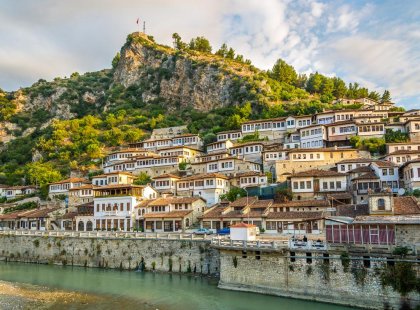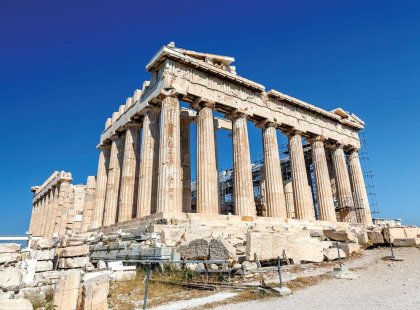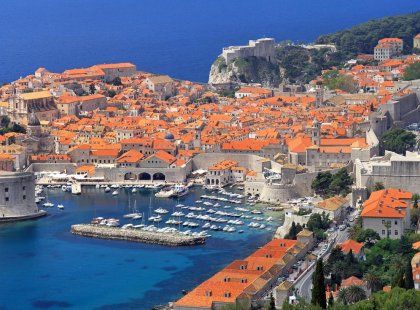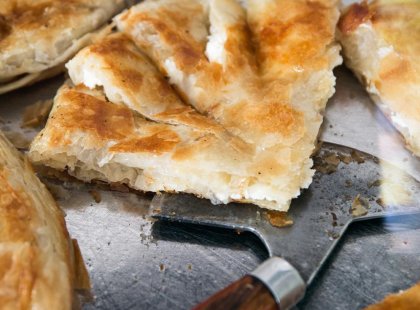Dubrovnik to Athens
15 days
from Hotel Dubrovnik to Saronic Gulf
From
$ 3205
Duration15 days
Experience the seaside charm of Dubrovnik and ancient culture of Athens. This adventure combines the must-sees of the Balkan region and the lesser-known glories of Macedonia and Albania to create the perfect balance between old and new. Hang out in Dubrovnik's Old Town, cruise around Lake Ohrid, climb Mt Olympus, the seat of the Gods, and sample some moussaka in Greece's capital. This whirlwind adventure through the Balkans is the best way to check out regional hot spots while also experiencing a hefty dollop of cultural hospitality.
-
Duration: 15 daysService level: Standard
-
Starts in: Hotel DubrovnikPhysical Grading: Light
-
Ends in: Saronic GulfAges: 15+
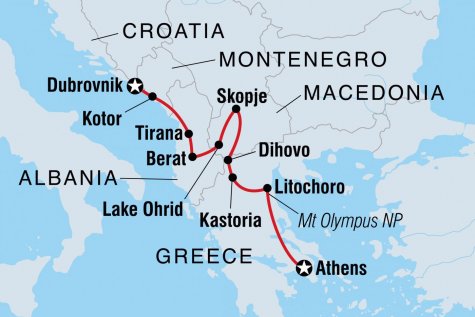
Itinerary
Day 1: Dubrovnik
Start place: Hotel Dubrovnik
Dobro Dosli! Welcome to Croatia, a place of sunshine, azure waters and scenery; home to chic cities, coastline, charming cobblestone towns, World Heritage sites, and a thriving food and wine scene. The undisputed jewel of the Dalmatian Coast, Dubrovnik old town is a beautiful white stone town surrounded entirely by city walls, easily covered on foot. Although it experienced devastation during the war in the early 1990s, the restored old town remains as charming as ever. If you have time why not head out to one of the Elafiti Islands. There's Lopud, a quiet island with lovely hikes, clean beaches and a ruined castle. Kolocep is a sleepy enclave that boasts walks for every fitness level, while Sipan is the most populated of the isles and reputedly has the most hospitable inhabitants. There are also many monuments to explore in the city proper, including the 15th century Rector's Palace, monasteries with cloistered gardens, and fine baroque churches with copper domes. The main pedestrian promenade, once a shallow sea channel, is now paved with glistening white limestone, in stark contrast to the warm red terracotta roofs. It is hard to imagine a more beautiful city. A walk along the city walls of ‘Game of Thrones’ fame is not to be missed. As there is not much time in Dubrovnik on this trip you may want to consider arriving a few days earlier.
Day 2: Kotor
Leave Dubrovnik behind and take a private transfer to Kotor on the Montenegrin coast (approximately 3 hours). This 5th-century World Heritage-listed city is set on a secluded bay, with towering peaks surrounding a rocky coastline dotted with pretty waterside towns. In its crooked alleyways, get lost and mingle with the locals. When you arrive, why not check out the 12th-century Cathedral, the South Gates, and the Armoury Square. Later, perhaps take a cruise on the Kotor Fjord – the longest fjord south of Scandinavia – and visit an island with a church that's almost as big as the island itself! In the evening the city walls are prettily lit up to provide a unique night-time perspective.
Meals: B
Day 3: Tirana
After breakfast, drive across the border into Albania. If you think you know Albania, think again. This addictive country has myriad faces. In the rugged north the Alps are so fierce they're deemed 'accursed', while the south enjoys one of Europe’s least known and most beautiful coastlines. A unique mixture of cultures and customs, Tirana is filled with craziness, from its traffic to its nightlife, but on its doorstep are mosques, citadels, Ottoman architecture, and a stunning dose of the medieval Balkans. The real surprise of Albania is the people. Their warmth to strangers is infectious and you’re bound to find yourself swapping stories over a glass of raki or three. Our first stop is the city of Shkoder (approx 3 hours drive from Kotor). Here you will have time to explore Rozafa Castle. The site was occupied by a fortress since Illyrian times, however most of what can be seen today is of Venetian origin. Depending on road conditions and volume of traffic it will be another 2 hours to Tirana. On arrival, take an orientation walk to get your bearings. Tirana is the capital of Albania and its biggest city, but it's still small and compact, with architectural influences from Italy and Turkey. Recently many buildings have been painted to alleviate the Soviet block feeling that pervaded. Many upgrades have been made all over town, such as new parks and wide pavements, a process that's still on-going.
Meals: B
Day 4: Kruja / Tirana
Today, take a half-day trip to the mountain village and former Albanian capital of Kruja. Kruja was the last stronghold of Skanderbeg's (the national hero of Albania) army until the Ottomans took over the entire country. There is plenty of time to explore the citadel and the famous bazaar area. Perhaps pay a visit to the excellent ethnographical museum housed inside the fortress. You’ll then return to Tirana after lunch. Tirana is dotted with many museums. You can't miss the National History Museum – just look for the gargantuan mosaic on the facade that represents the development of Albania's history. The main sight in Tirana is the Et'hem Bey Mosque, which sits right on the city's main square. Closed under communist rule, the mosque resumed as a place of worship in 1991. Ten thousand people attended the reopening and the event was considered a milestone in the rebirth of religious freedom in Albania. The mosque is currently closed for extensive renovation works, but you can still take a look at the frescoes outside and in the portico that depict trees, waterfalls and bridges – motifs rarely seen in Islamic art.
Meals: B
Day 5: Berat
Travel by public bus to Berat, the town of a thousand windows, one of the few towns of Albania that escaped being razed to the ground to make way for apartment blocks. The old Mangalemi district has recently been inscribed on UNESCO's world heritage list. Enjoy an afternoon guided tour of the town and the looming fortress, the kala, built during the 13th century and still inhabited. The walk to the castle is steep and slippery so better bring some proper footwear with you. The views from the top across Berat and the Osum river valley are well worth the effort though.
Meals: B
Day 6: Lake Ohrid
Travel by private bus to Ohrid in Macedonia, a drive of about 3 hours, situated on a lake with the same name. Europe’s oldest lake, and one of the oldest human settlements in the world, Ohrid has a wealth of historic sites and religious monuments to discover. Ohrid is an eternal town, a magical hill whose primordial pulsation links ancient and modern times forever. The town is said to have once been home to 365 churches, one for each day of the year, earning it the nickname “the Macedonian Jerusalem”, while historical excavations date back to Neolithic times. Despite being a World Heritage site for over 30 years, the town remains under the radar of visitors. Get your bearings on an orientation walk around Ohrid, maybe picking up a bargain or two in the vibrant Old Bazaar. Then embark on a scenic cruise on the turquoise waters of Lake Ohrid, ringed by mountains, attractive villages and beaches, and take in the views of the town and the surrounding scenery while afloat.
Meals: B
Day 7: Lake Ohrid
At 34 kilometres long, 14 kilometres wide, and over 300 meters deep, all shared between Albania and Macedonia, there’s plenty of vast Lake Ohrid to explore. Today is free for you to discover the area. There are many churches and monasteries to visit, but one of the most popular is the Macedonian Orthodox Church of Sveti Jovana Kaneo, situated on a rocky outcrop above the town, overlooking the lake. Past the church you can wander around to the back of town, exploring the old walls and fortress, and admiring the views of the lake. The Sveti Naum Monastery is also a great option, lying on the shores of the lake south of town, with well-kept grounds that are home to peacocks. The ancient Tast Samoil’s Fortress stands on the top of Ohrid Hill and looks across the town, while a 2,000-year-old Roman theatre was uncovered near the Upper Gate – in summer it’s again being used for concerts and performances. During your time here you may also want to try one of the endless number of hikes found in the mountainous Galicica National Park, sampling some of the flora, fauna, and spectacular views.
Meals: B
Day 8: Skopje
This morning hop onto public bus to Skopje, Macedonia's capital city (approximately 3 hours). In Macedonia’s political and cultural centre, walk past Byzantine domes, Turkish baths, and also newly built neo-classical buildings and grand monuments (aimed to bolster national pride), sampling gozleme and tasty baklava along the way. The 30 mosques, innumerable caravanserais and hamams that fill its winding streets are a testament to Skopje’s Ottoman past. Take a step back to those times with a visit to the Daut Pasha Hamam, or journey through the humbling Holocaust Museum to learn how Macedonia suffered during this tragic chapter of history. Get lost in the narrow lanes of Caršija, Skopje's most atmospheric neighbourhood, or take in the stone bridge over the river Vardar – an iconic sight that acts as a handy connection between Macedonia Square and the Old Bazaar. Perhaps visit the Museum of the City of Skopje, housed in the old Railway Station, which is itself a unique piece of history. Its unusual, part-ruined exterior is a result of the 1963 earthquake. The large clock on the outside of the building is frozen at 5:17, the moment the earthquake shook the city.
Meals: B
Day 9: Matka Canyon / Skopje
Venture out to Matka Canyon, a deep ravine cut into the Suva mountains by the Treska River, 15 kilometres southwest of the city. This area is home to several medieval monasteries, caves, and over 70 species of endemic butterflies. There is the option to explore the canyon's sights by boat. One of the monasteries worth exploring is St Andrew's Monastery, which contains many superb frescoes of great artistic importance. There is also Vrelo cavern, a water-filled cave with incredible stalagmites and unchartered depths – it's speculated to be the deepest underwater cave in the world. Alternatively, you can take one of the many nature walks in the canyon, or up to tracks that hug the ridge high above the valley. Return back to Skopje, with the remaining part of the day free for you to continue exploring this exciting city. Perhaps take the Mount Vodno cable car to the giant 66-metre high Millennium Cross, mainly for the views back down across the city. For dinner this evening head to the Old Bazaar, or the restaurants in the Debar Maalo area.
Meals: B
Day 10: Dihovo
A 3-hour public bus ride will take you to Dihovo, a village located in the Baba Mountain massif whose surroundings are known for their ancient Molika pine trees. You’ll enjoy a homestay tonight in a restored traditional house, built in the typical Macedonian stone-and-wood style. Enjoy a great wine tasting experience tonight – the owner produces his own prize-winning wine, and you’ll get to taste it while trying many local delicacies, including homemade bread, jams, and salami.
Meals: B, L, D
Day 11: Kastoria
Travel with our private transport to the border with Greece and then continue to Kastoria. This medieval town sits on the western shore of Lake Orestiada, in a valley surrounded by limestone mountains. Kastoria is full of interesting Byzantine churches and Ottoman-style architecture, including old distinctive villas from the skin and fur trade times. Once you arrive you’ll take an orientation walk along the labyrinthine lanes, with time to walk along the lakeside, where boats bob, Dalmatian pelicans and ducks make iridescent ripples on the water, and coniferous trees and mountains surround in the distance. Later, consider visiting the unspoilt Spilia tou Drakou, or Dragon Cave, one of the most impressive caves in Greece, and see stalactites and underground lakes in this mysterious natural wonder once believed to be a gold mine guarded by a sleepless dragon.
Meals: B
Day 12: Litochoro
Enjoy a free morning in Kastoria. Perhaps visit the Neolithic lakeside village and reconstruction at Dispilio, which gives you a real feel for life in a village in the middle of the 6th Millennium BC. After lunch transfer by private vehicle to the town of Litochoro at the base of Mt Olympus. Upon arrival head out on a short orientation walk to familiarise yourself with the surroundings. Head down to the beach at Pláka for some well-deserved relaxation and a dip in the Aegean Sea before tomorrow's hike. Perhaps have dinner in one of the fish tavernas lining the sea shore, and indulge in some traditional dishes.
Meals: B
Day 13: Mt Olympus National Park
Mount Olympus, Greece's first national park, is the highest mountain in Greece and the second highest in the Balkans, with a height of 2918m. The mountain is famous in Greek mythology as it is the dwelling of the twelve Olympian gods, headed by Zeus. Mytikas peak was the gods' meeting place, and Stefani peak was the Throne of Zeus from where he was said to have displayed his mighty power by throwing thunderbolts. Head out early today for a hike along a lush trail within the national park to a beautiful waterfall. If it's a hot day why not brave the cold water. Just don't forget to bring your bathers. There is the option to visit the monastery of St Dionysios on the way back into town. The rest of the day is free for you to continue enjoying the surrounding countryside or simply take in the view of the mountain from the vantage point of the nearby beach.
Meals: B
Day 14: Athens
Board a public bus to Athens, the beating heart of Greece, and the centre of the ancient world (approx 5.5 hours). After arriving and transferring to your central hotel, there's much to be seen in the capital of Greece, vibrant and refreshed following the 2004 Olympics, yet still retaining so much visible history. Named after the goddess of wisdom, Athens has a weighty history that spills out over the modern city, represented most dramatically by the ancient Acropolis, where you can enter the Pantheon and enjoy fabulous views over the city. The birthplace of Western civilisation, Athens has an amazing array of historic sites to explore, including the National Gardens, the Temple of Olympian Zeus and the original Olympic Stadium. Another highlight is the renowned changing of the guard at Syntagma (Parliament) Square. Afterwards, perhaps tuck into a delicious dinner of Greek cuisine and a shot (or two) of ouzo.
Meals: B
Day 15: Athens
There are no activities planned for the final day and you are able to depart the accommodation at any time. As there is so much to see and do in Greece's capital you may want to extend your stay here. We are happy to assist with additional accommodation, subject to availability. Please enquire at the time of booking.
End place: Saronic Gulf
Meals: B
Inclusions
Included
- Shkoder Rozafa Castle
- Kruja Day Trip
- Kruja Skanderbeg Museum
- Kruja Fortress
- Berat Guided Walking Tour
- Berat Castle
- Lake Ohrid Boat Cruise
- Day Trip to Matka Canyon
- Dihovo Wine Tasting
- Olympus Orlias Waterfall Hike
-
Transport
Public bus, Private vehicle, Taxi, Boat -
Accommodation
Hotel (10 nights), Guesthouse (2 nights), Homestay (1 night), Hostel (1 night)


